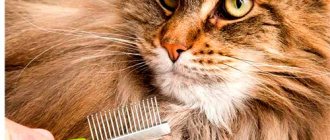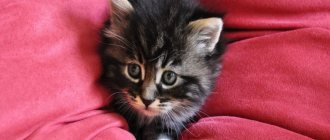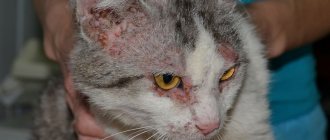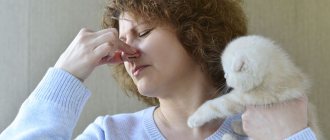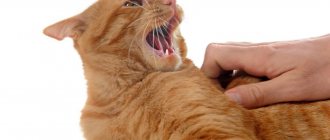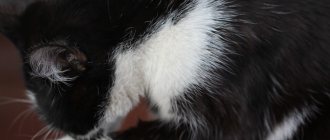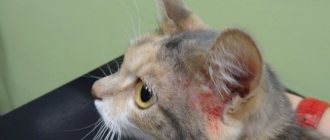Often, hair loss in cats occurs due to psychological problems, infections or parasites. Then the cat itches, does not allow its owners to come near it due to discomfort, and the fur comes out in clumps. Most often, the cat's stomach, area around the eyes and on the neck become bald; the hairs grow unevenly. To restore your pet's health, you must urgently contact a veterinarian. A specialist will help identify the source of the problem and eliminate it.
Description and symptoms of the disease
Alopecia or baldness is the loss of fur in cats. Bald patches and bald spots above the eyes, on the stomach, on the back, heel and hind legs indicate the development of diseases in the pet, although the reason why these parts of the body are bald cannot always be identified. But doctors tend to believe that the animal is going bald due to psychological problems. In this case, the animal loses hair only in small quantities or en masse. The cat becomes bald at the tail or just at the tip, on the head, back, legs, heels and behind the ears. The disease in a kitten is accompanied by itching and pain at the sites of injury. The cat's fur is falling out in clumps or has become bald. The skin in these areas becomes dry and flaky. Redness or sores may appear.
Varieties
According to the candidate of veterinary sciences A. N. Gerke, which is set out in the scientific work “Diagnostic approach and therapy for non-inflammatory alopecia in cats,” the most common type is self-induced baldness. This type of disease appears when the cat begins to lick its fur on its own to the point of becoming bald and mangy. The back legs or the area near the head are especially affected when the kitten scratches its neck. In such cases, the animal does not experience discomfort and allows you to touch the damaged areas. There is also symmetrical alopecia - hair loss in cats of the same size in different parts of the body. In addition, there is a random form, when the cat’s hair falls out unevenly and the bald spot is located in several areas.
Scientific work of A.N. Gehrke
Causes of the disease
At the site where ringworm appears, the animal's hair falls out and severe itching is felt.
The most common source of disruption is stress. Cats are especially susceptible to this during pregnancy or lactation. Then the cat becomes bald on its stomach and legs. Alopecia in cats occurs as a side effect of the use of medications, such as antibiotics. Also, bald spots in cats develop after injections at the injection sites. If your cat's ears and heels are going bald, this could be a sign of ringworm. Then the bald spot becomes crusty, very itchy and flaky.
Alopecia in cats occurs due to the spread of fleas or ticks throughout the pet's body. Another common cause is allergies to environmental objects: food, metals, chemicals. Then red baldness and dryness appear. A cat's hair falls out in clumps due to solar dermatosis. White individuals are prone to this violation. As a result of the pathology, they develop sores, wounds near the eyes, nose and ears, and the tail becomes peeling. A cat's tail peels off (either completely or just the tip) due to seborrhea. This type of disease can be congenital or acquired. The disease is accompanied by an unpleasant odor, the skin becomes oily or dry, scales or a red spot form on the belly or withers. If you see bald patches above the eyes of a cat with short hair at the age of 14-20 years, then there is no need to worry too much. This is a natural phenomenon and does not require treatment.
There are such reasons why fur falls out and a bald spot appears on the stomach and hind legs:
- cheyletiellosis;
- folliculitis;
- adenitis;
- hyperthyroidism;
- neurogenic dermatitis;
- nesting baldness;
- seborrhea;
- hyperadrenocorticism;
- demodicosis;
- diabetes;
- adrenal gland diseases;
- erythema.
Why do cats lose hair on their back legs?
Hair loss occurs in response to many factors, including poor diet, autoimmune diseases, fungal infections, allergies and parasites.
Hair loss in cats can be partial or complete, and the pattern can vary or be symmetrical. The skin around the balding area may appear normal or may appear red, bumpy, or crusty. Hair loss is a symptom and treatment requires identifying the root cause. If your cat is experiencing hair loss and is scratching the area excessively, the first thing to investigate is the itching. Below are the four most common causes of hair loss on the hind legs in cats.
© shutterstock
Fleas and other parasites
Fleas are one of the most common causes of hair loss on the back legs of cats. Fleas are no fun for any cat and can cause a lot of discomfort. Many cats develop allergies to flea bites. Hypersensitivity (allergy) to flea bites or flea allergy dermatitis (FAD) is very common in cats. In these cats, just one flea bite can cause severe and prolonged itching, which often leads to hair loss and can lead to open sores or scabs on the skin, leading to a secondary bacterial infection.
Many cats will chew or lick fur from their legs excessively when they have fleas or FAD. Hair loss on the neck, legs and base of the tail can also be seen along with small, hard crusts called miliary lesions, a term coined because the crusts look like millet seeds.
Because flea saliva causes a reaction, the most important treatment for flea allergies is preventing fleas from forming. Both indoor and outdoor cats can become infected with fleas, so monthly veterinarian-approved flea prevention is recommended to help prevent fleas.
Other parasites, including ticks and ringworm, can also cause excessive scratching, licking or chewing, but fleas most often cause hair loss on the hind legs.
Pain
Cats that are in pain may overgroom the painful areas. Lower urinary tract disease and feline arthritis are two common causes of pain and discomfort in cats. In response to this pain, they may overgroom, to the point of losing hair on the lower abdomen, the inside of the hind legs, and around the genitals.
Pain can be difficult to assess in cats, so it is important to know the signs of pain in cats and contact your veterinarian.
Always consult your veterinarian for an appropriate pain management plan. Their plan may include pain medications, laser therapy, acupuncture, and nutritional supplements.
© shutterstock
Allergies
Food allergies, environmental allergies, and flea allergies, as mentioned above, can also be some of the reasons why your cat is experiencing hair loss on the hind legs. The first step in treating allergies is to find the source of the allergen and eliminate it. When it comes to food allergies, most cats are actually allergic to protein rather than other nutrient sources.
A hydrolyzed diet is a food in which protein is broken down into its individual amino acid components. This prevents your cat's immune system from identifying the food as containing an allergen and prevents her from developing symptoms of a flare-up of her allergies. Other allergens, such as mold in the environment, can cause itching, scratching and over-grooming.
Stress and anxiety
Cats are creatures of impeccable cleanliness and fastidious groomers. Cats typically spend 30 to 50 percent of their day grooming themselves. However, if your cat grooms itself to the point of hair loss or skin sores, it may be suffering from an underlying medical condition as stated above, or a psychological problem.
Grooming is a normal response for cats to feel better in stressful situations or when they are anxious. It can become obsessive if grooming behavior is performed out of context and so frequently that it disrupts normal functioning. Areas that cats typically stop grooming due to stress include the abdomen, inner thighs, and lower back.
Cats can become overly groomed when their caregivers are not present, so this may be difficult to notice. Most caregivers will notice areas where hair is thin or missing. Some cats will only lick one area, while other cats may over-groom in more than one area.
Grooming disorder, also known as psychogenic alopecia, is usually caused by a change in the cat's daily routine or environment, such as moving to a new home or introducing a new family member or pet. Other stressors may include tension between cats, excessive competition for resources, and boredom.
It is important to have a veterinarian rule out medical problems. Cats with psychogenic alopecia often experience hair loss without skin inflammation, although over-grooming can lead to secondary infections and irritation, and under a microscope, your cat's hair will appear completely torn or broken off near the surface of the skin.
Treatment involves determining the root cause with your veterinarian, identifying any stressors and eliminating them if possible, providing mental and physical enrichment, maintaining a consistent routine, and creating a less stressful environment. You can create a less stressful environment by adding hiding places and vertical places for your cat, playing with your cat more, and using products that mimic the chemical that cats secrete through glands on their face when they feel calm and want to communicate it.
Diagnostic methods
After conducting an examination, the veterinarian will prescribe treatment according to the reasons that provoked the problem.
It is not recommended to self-medicate. As soon as your cat's fur begins to peel off, you should contact your veterinarian. He will conduct a series of studies to identify the cause of alopecia and prescribe therapy. First, the doctor learns about how the animal eats, where it lives and how often it goes outside. This helps to identify the source of the pathology. Next, he examines the cat, checking the condition of the hair using a microscope. The pet must undergo blood tests, hormone tests and scrapings to find out why the cat is bald and shabby. To identify the development of disorders of internal organs, it is necessary to do an ultrasound examination or radiography.
Skin diseases in cats
Skin diseases in cats are at the forefront of modern veterinary medicine. This is due to poor nutrition - poorly selected feed, illiterate breeding work, and poor environmental conditions play an important role. Due to the above factors, local or widespread rashes, ulcers, etc. may be observed on the skin. Below are all the skin lesions of cats, grouped into groups according to clinical symptom complexes.
Miliary dermatitis
Miliary dermatitis is characterized by the formation of dry or weeping, cavity-free elements on the skin. They are located on the surface in the form of small elevations, form crusts or peel off, fester or are presented in the form of small nodules. Miliary dermatitis covers most of all skin diseases and can be caused by the following reasons.
Allergies to food, hygiene products or medications.
Damage to the skin by a fungal or bacterial infection.
Damage to the skin by ectoparasites (bites of fleas, ticks, lice eaters).
Atopic dermatitis.
Infection with ectoparasites
The most common cause of miliary dermatitis. The cause is an allergic reaction to the saliva or excrement of the parasite. Accompanied by more or less severe itching and scratching. The parasite can be identified through a routine examination and combing the animal's fur onto wet white paper.
Upon examination, blood-sucking ticks, fleas and cheylitelas will be noticeable. Cheylitelas are also called “creeping dandruff”, as they look like small, gray, constantly moving scales.
If, upon examination and combing, parasites or their waste products are not found, it is advisable to conduct a deeper examination of the skin with scrapings taken to exclude damage by scabies mites.
If the results of the above diagnostic measures are negative, it is recommended to examine the stool for worm eggs. Helminths can cause allergic miliary dermatitis.
Treatment is best carried out on the advice of a veterinarian. He will prescribe the most optimal drug and duration of treatment, taking into account the pathogen and the degree of damage. It should also be remembered that parasites live on cats and multiply in the environment, so treating an animal also involves treating the owners’ clothes, carpets and the apartment as a whole.
Skin infection due to fungal infection
Characterized by the presence of alopecia (baldness). On hairless areas, hard-to-remove white or pale gray scales form, under which hyperemic, thinned skin is revealed. The presence of itching and its intensity depend on the type of pathogen and the degree of damage.
It is also advisable to treat a fungal infection on the recommendation of a veterinarian. Depending on the strain of the fungus and the degree of damage, only light local treatment or long-term complex treatment with additional vaccination may be needed. It is not recommended to prescribe antifungal drugs or hygiene products with an antimycotic effect on your own. Many of them are toxic, and certain breeds of cats are especially susceptible to them.
Skin damage due to bacterial infection
Suppuration of existing wound surfaces, scratches, and folds occurs. Bubbles, crusts, pustules or scales form at the site of the lesion. As a rule, the process affects only the superficial layers of the skin; deeper lesions should suggest more serious conditions (decreased immunity, use of glucocorticoids, neoplasms, viral infection). It is best to prescribe antibacterial therapy after bacterial culture of a scraping of the affected area of the skin and determination of sensitivity to antibiotics.
Allergic dermatitis
Caused by foods, certain plants, medications, or the sun. It manifests itself as itching and rashes in the muzzle, on the tips of the ears, along the lower edge of the eyelid or in the area of the nose and lips. Hairless areas appear on the sides and stomach.
As a rule, the disease occurs annually, at the same time, gradually progressing. Without treatment over several years it leads to squamous cell skin cancer.
Atopic dermatitis
Similar to allergies, but more severe and more acute. Appears as a pathological reaction to ordinary products and agents that, in principle, are not allergens.
Alopecia (baldness)
Alopecia can be either an independent disease or a symptom of other common diseases among cats. It can be congenital or acquired. Congenital alopecia and hereditary hypotrichosis are manifested by an abnormally low number of hair follicles. This occurs only in certain breeds - sphinxes, Devon rexes, etc.
Acquired alopecia includes seasonal molting, complications of miliary dermatitis, traumatic and psychogenic alopecia. With psychogenic baldness, a cat, due to a behavioral disorder, plucks or intensively licks its fur. Traumatic alopecia forms at the site of injections, collars or other injuries.
Endocrine alopecia is also distinguished - it is symmetrical on both sides of the body, and can be caused by disorders in any of the endocrine organs.
Pigmentation disorders
Albinism is a birth defect. It is not subject to treatment, and the animal is not allowed for breeding.
Periocular leukotrichia. Develops as a result of stressful situations in some breeds. It manifests itself as lightening of the fur around the eyes. It does not require treatment and goes away on its own.
Lentigo . These are dark spots that appear on the gums, nose, lips or eyelids. There is no cure. The disease is not dangerous and is only a cosmetic problem.
Tumors
Skin tumors can be either benign or malignant. This is difficult to determine visually even for a veterinarian, so any tumor in your cat requires additional examination. The sooner this is done, the greater the likelihood of a successful outcome.
Diseases of subcutaneous fat and sebaceous glands
Panniculitis is an inflammation of subcutaneous fat. It is characterized by the appearance of bubbles with liquid in the lower part of the chest or symmetrically on the sides. After some time, the blisters open and form ulcers with oily contents. Ulcers do not heal for a long time; deep scars remain in their place.
Acne - comedones. They arise as a result of disruption of the sebaceous glands. Rashes appear on the cat's face. Acne can become inflamed due to a bacterial infection.
Seborrhea. It can be dry and oily. Dry seborrhea is dry white scales that appear on dry, thin skin. It is most often the result of stress and can occur within a few hours. Oily seborrhea is the same as scales only on oily skin and hair. It is the result of a disruption in the functioning of internal organs, most often the liver and pancreas.
Inflammation of the perianal glands. Occurs rarely. You can suspect it if the cat constantly licks and scratches the anus, and defecation gives her pain and discomfort.
Hyperplasia of the tail glands. The waxy secretion of the sebaceous glands accumulates in the upper part of the tail, where there are especially many of them. The base of the tail thickens, and an oily secretion of gray-yellow color is released. The coat becomes thin and dull.
Any skin disease in a cat requires adequate diagnosis and treatment. After all, they can signal more serious violations. There is no need to treat abrasions and scratches; cats themselves lick such damage. damage
How to treat the disease?
To quickly cure a cat, you need to know the source of the disease and why the cat’s hair came out. If a cat suffers from baldness due to allergies, then the owner must protect the pet from the irritant. Afterwards, the cat is prescribed histamines, immune system stimulants and hypoallergenic products. If the source is parasites, then bald spots on the tail, back, and legs are treated with ointment against ticks or fleas. In addition, the veterinarian prescribes medications that improve the functioning of the immune system. For endocrine diseases, drugs are used that restore the action of the glands. If alopecia in cats is caused by an abscess, then antiseptics and antibiotics are prescribed.
Baldness of a psychogenic nature is treated with soothing drops on a natural basis.
Physiological causes of alopecia in cats
The cause of sudden hair loss can be directly related to the physiology of the animal, without being a disease:
- Seasonal shedding. This natural process is characterized by partial hair loss, during which the animal’s fur falls out in clumps, and new hair grows in its place. The pet looks healthy, behaves as usual, and the skin in the areas of loss has no visible damage (scratches, crusts or peeling).
- Pregnancy and breastfeeding. Oddly enough, cats also experience stress before and after birth, a lack of minerals and vitamins, which kittens take away. This often results in partial baldness, mainly on the cat's belly. During the nursing period, it is recommended to add vitamin and mineral supplements to the cat's food.
- Changes in hormone levels. If an animal receives hormonal drugs to suppress sexual activity, there is a possibility of changes in the pet's hormonal levels, which also has a negative effect on the hair coat. Age-related changes. As your pet ages, their fur becomes thinner, which can lead to baldness around the eyes and ears.
All of the above reasons are physiological in nature. In most cases, the problem is solved by a small change in diet, and sometimes it goes away on its own.
Prevention
Problems when a cat has bald ears, belly, peeling heels, back or tail at the base arise quite often, but they are quickly treated. But in order not to injure the animal, violations should be prevented. To prevent the appearance of alopecia, veterinarians recommend monitoring the hygiene and nutrition of the animal. The cat must be kept in clean conditions so that it does not get infected. In order to identify violations in time, it is advised to regularly consult a doctor and independently check the condition of your pet’s skin. This will allow you to find out at the first stages of the development of the pathology why the fur is coming out and remove the disease. If hair falls out on the ears or the back becomes bald, you cannot treat it yourself, so as not to worsen the condition of your pet.
Causes of hair loss: skin diseases
Skin diseases most often provoke focal loss of skin (bald spots). In this case, the skin lesion is accompanied by severe itching, and the scratching becomes suppurated.
Fleas
Parasites change the behavior of a pet - the cat suddenly begins to itch, and the unbearable itching bothers the pet both day and night. The animal bites off the fur in shreds, and the scratches become covered with crusts. Possible infection (purulent crusts). A large population of fleas also affects the general condition: the cat loses weight, becomes restless and angry for no reason. Even the owners themselves can suffer from fleas: insects from the floor bite their legs.
Ticks
When a pet is infected with ticks, bald spots appear on the muzzle, ears and front legs. Areas of baldness are often located symmetrically. Severe itching leads to scratching, and the wounds often fester. You should be aware of demodicosis, a disease caused by microscopic skin mites. Demodex usually develops in pets with weak immune systems. The red areas are covered with dry scales.
Allergy
An inadequate immune system response can occur when using antibiotics, household chemicals (detergents, air fresheners), plants (toxic to pets or pollen), food ingredients and care products (shampoos), metals, and even plastic and rubber. Inflammatory lesions (dermatitis) appear on the skin: the skin in the reddened areas is red, with scratches. The cat is constantly itching and irritable, often refuses to eat, but drinks normally. Allergies can cause watery eyes, nasal congestion and ear inflammation.
Lichen
A cat disease caused by a fungus is dangerous to humans. On a cat, lichen looks like round lesions with stubs of hairs. The red skin is covered with scales, and the pet is constantly itching. Gradually the spots increase in size.
Adenitis
Inflammation of the sebaceous glands is caused by a genetic predisposition. Active manifestations more often occur in teenage and older kittens. Round bald spots appear on the ears, neck and head. The cat itches and emits an unpleasant odor. Later, baldness spreads along the back to the tail; gray or yellowish patches are sticky. Adenitis is often confused with eczema. However, in the latter case, it is important to check immunity, liver function and the entire digestive tract.
Folliculitis
Infection. affecting hair follicles. initially provokes fragility of the pet's hair. Inflamed blisters appear on the face and neck, accompanied by itching. Folliculitis often occurs due to allergies or infection with the feline immunodeficiency virus.
Alopecia areata
Autoimmune pathology is manifested by the periodic appearance of foci of baldness, their growth (increase in size) and the gradual restoration of fur. There is no itching. Symmetrical alopecia is extremely rare: patches of baldness appear in the groin, thighs and abdomen of the cat.
Seborrhea
May be congenital or acquired due to internal diseases. It appears as patches of baldness covered with small scales. The pet's fur is covered with dandruff, and the animal emits an unpleasant odor. Itching provokes scratching.
Hypotrichosis
A genetic abnormality leads to complete hair loss in childhood. Newborn kittens initially have very sparse hair and become completely bald within 3-4 months. It is important to remember: cats without fur freeze in winter and quickly overheat in summer. Monitor your pet's drinking regime in hot weather and keep the animal warm in cold weather.
Treatment
In case of baldness of the abdomen, it is recommended to carry out treatment prescribed by a specialist depending on the cause of the pathology. You can only overcome baldness on your own, which is the result of skin parasites. They are easily removed using specialized shampoos, drops and collars.
Previous
Questions and answers Paste for removing hair from the stomach of cats
Next
Questions and Answers How to remove fur from a cat’s stomach at home
Great article
